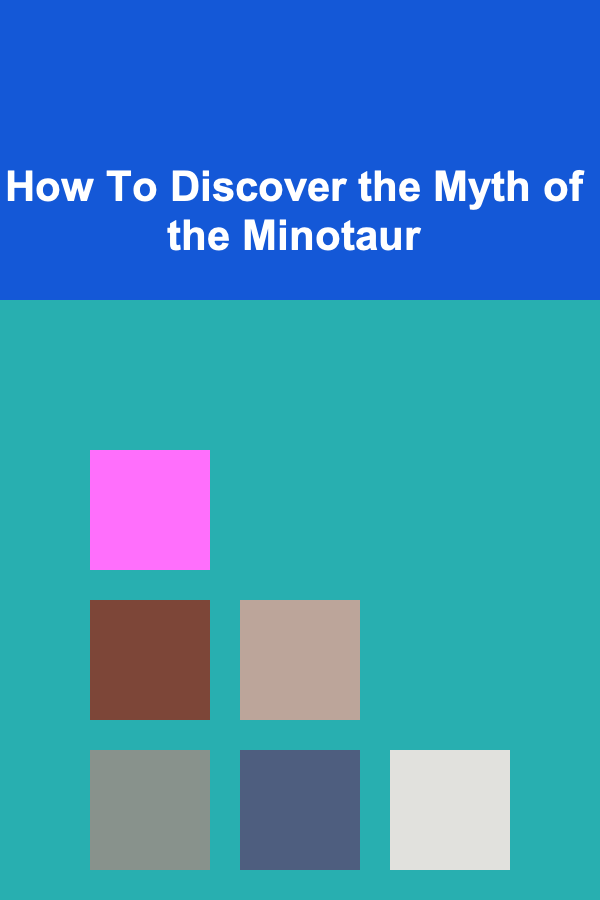
How To Discover the Myth of the Minotaur
ebook include PDF & Audio bundle (Micro Guide)
$12.99$9.99
Limited Time Offer! Order within the next:

The myth of the Minotaur is one of the most iconic and enduring stories in Greek mythology, captivating audiences for thousands of years. This half-man, half-bull creature has been the subject of countless interpretations and retellings across different cultures and artistic mediums. But how does one "discover" the myth of the Minotaur? What does it mean to explore this ancient tale and uncover its hidden meanings, symbolism, and influence? In this article, we will delve into the history, interpretation, and legacy of the Minotaur, attempting to answer these questions and more. To understand the myth fully, we must trace its origins, its context within Greek mythology, the key characters involved, and its lasting cultural impact.
Origins of the Minotaur
The Minotaur, known as the "bull of Minos," appears in the ancient Greek mythological tradition, primarily found in the epic poem The Odyssey by Homer and later in works by authors such as Ovid and Apollodorus. The creature is typically depicted as a monstrous hybrid, possessing the body of a man and the head of a bull. The story of the Minotaur is centered around the island of Crete and its ruler, King Minos.
The origin of the Minotaur is linked to the god Poseidon, who played a crucial role in the story. According to the myth, Minos, the king of Crete, sought Poseidon's favor to prove his right to rule. As a sign of his approval, Poseidon sent Minos a magnificent white bull from the sea. Minos, however, decided to keep the bull for himself rather than sacrifice it as instructed by Poseidon.
In retaliation, Poseidon cursed Minos' wife, Pasiphae, making her fall in love with the bull. The result of this unnatural union was the Minotaur, a creature that was part man and part bull. Unable to control or contain the beast, Minos ordered the construction of the labyrinth, a complex maze designed by the architect Daedalus, in which the Minotaur would be imprisoned.
The labyrinth became the setting for one of the most famous episodes in Greek mythology --- the story of Theseus and the Minotaur. Theseus, the prince of Athens, volunteers to enter the labyrinth to slay the Minotaur and end the terror it caused. With the help of Minos' daughter, Ariadne, who provides him with a ball of thread to find his way out, Theseus successfully navigates the maze, kills the Minotaur, and escapes.
The Symbolism of the Minotaur
The Minotaur myth is rife with symbolic meaning, offering a rich tapestry of themes that have been explored by scholars, psychologists, and artists for centuries. At its core, the story represents the struggle between human reason and the untamed forces of nature. The Minotaur itself embodies the primal, animalistic side of humanity --- a side that is often feared, repressed, or misunderstood.
The labyrinth, in which the Minotaur is trapped, symbolizes the complexity and confusion of the human psyche, a maze of emotions, instincts, and desires that can often feel impossible to navigate. The hero, Theseus, represents human intellect, courage, and the capacity for overcoming chaos. His journey through the labyrinth is metaphorical, reflecting the process of confronting and mastering our own inner monsters.
The Minotaur as a Representation of Human Nature
One of the most compelling interpretations of the Minotaur myth is its exploration of the duality of human nature. The creature itself is both human and animal, symbolizing the tension between civilization and the wild, the rational and the irrational. The bull, as an ancient symbol of strength and virility, stands in contrast to the human body, which represents intellect, order, and society. The Minotaur is neither fully one nor the other, but an uncomfortable hybrid of the two.
Psychologically, the Minotaur can be seen as a representation of repressed desires, fears, or aspects of the self that society deems unacceptable. Theseus' triumph over the beast represents the conquest of these inner demons, suggesting that it is only through facing and understanding our primal instincts that we can hope to gain control over them.
The Labyrinth: A Metaphor for the Human Condition
The labyrinth itself is another powerful symbol in the myth. It is a structure designed to disorient and trap its inhabitants, much like the confusion and disarray that often characterize human life. The complexity of the maze mirrors the complexities of existence, filled with obstacles, twists, and turns that seem insurmountable at times. Just as Theseus must rely on Ariadne's thread to navigate the labyrinth, humans must often rely on guidance, wisdom, and clarity to find their way through life's challenges.
Furthermore, the labyrinth can also be viewed as a metaphor for the journey of self-discovery. Just as Theseus must venture into the heart of the labyrinth to face the Minotaur, individuals must confront their own fears, insecurities, and hidden aspects of their personality to grow and evolve. The labyrinth represents the internal journey that all individuals must undertake to find meaning and purpose in their lives.
Theseus and the Minotaur: A Hero's Journey
The story of Theseus' confrontation with the Minotaur fits the mold of the classic "hero's journey," a narrative structure that has been identified in myths, literature, and films across cultures and time periods. The hero's journey typically involves several stages, including the call to adventure, the descent into darkness or chaos, the encounter with a great challenge, and the eventual triumph over adversity.
In the case of Theseus, his "call to adventure" is the desire to rid Athens of the tribute it must pay to Crete --- sending young men and women as sacrifices to the Minotaur. His journey into the labyrinth represents the descent into the unknown, the darkness where the Minotaur lurks. The encounter with the Minotaur is the moment of greatest danger and tension, but it is also the moment of transformation. By defeating the creature, Theseus not only saves Athens but also demonstrates his own heroism and mastery over fear.
This mythic structure --- the hero who ventures into darkness, faces trials, and emerges victorious --- is a recurring theme in many cultures. It speaks to the universal human experience of confronting and overcoming challenges, both external and internal. The Minotaur, as the antagonist, plays a crucial role in this narrative, serving as the force that the hero must defeat in order to prove his worth and gain wisdom.
The Minotaur in Art and Literature
The Minotaur has had a profound influence on art, literature, and culture for centuries. The imagery of the half-man, half-bull creature has been depicted in countless paintings, sculptures, and literary works, often as a symbol of human struggle, fear, and the tension between civilization and savagery.
In modern literature, the Minotaur often serves as a metaphor for various aspects of the human experience. In works such as The Myth of the Minotaur by Robert Graves and The Minotaur by Thomas Burnett Swann, the creature is portrayed as a tragic figure, caught between two worlds and doomed by forces beyond its control. These interpretations often emphasize the Minotaur's humanity, portraying it not as a mere monster but as a symbol of alienation, desire, and the search for identity.
In art, the Minotaur has been portrayed in a variety of ways, from the classical depictions of the creature in ancient pottery and sculpture to the surrealist interpretations of artists such as Pablo Picasso and Salvador Dalí. Picasso, in particular, was fascinated by the image of the Minotaur, using it as a symbol of both his own psychological turmoil and the turbulent times in which he lived. The Minotaur became a recurring motif in his works, representing the duality of human nature and the complexities of the subconscious mind.
Modern Interpretations of the Minotaur
The Minotaur's role in contemporary culture has evolved, often being used as a symbol of the darker side of the human psyche. In popular media, the Minotaur has appeared in various forms, from the fantasy genre to horror films and video games. The creature is often depicted as a villain or antagonist, but its symbolic significance remains unchanged --- it represents the untamed, chaotic forces that threaten to overwhelm order and reason.
In the world of psychoanalysis, the Minotaur is sometimes interpreted as a symbol of the unconscious mind, the hidden desires, and impulses that lie beneath the surface of human consciousness. Just as Theseus must confront the Minotaur in the labyrinth, individuals must confront their own subconscious fears and repressed emotions in order to achieve personal growth and self-awareness.
Conclusion
The myth of the Minotaur is a powerful and multifaceted story that has resonated with people for millennia. It speaks to the universal human experience of confronting darkness and chaos, both in the external world and within the self. Through the lens of this myth, we can explore themes of duality, repression, identity, and the heroic journey. Whether viewed as a literal tale of a hero battling a monster or as a metaphor for the inner struggles we all face, the Minotaur myth offers timeless insights into the human condition.
To "discover" the myth of the Minotaur is to engage with its many layers of meaning, from its origins in ancient Greece to its modern-day interpretations. It is a myth that challenges us to confront the labyrinths within our own lives, to face our fears and desires, and to emerge from the darkness stronger and more self-aware. The Minotaur may be a creature of legend, but the lessons it imparts are as relevant today as they were in the ancient world.

How to Design a Small Kitchen That Feels Spacious
Read More
How to Organize a Home Inventory for DIY Projects
Read More
How to Prepare Your Home for a Long Absence
Read More
How to Save Money on Furniture and Home Appliances
Read More
How to Understand Rental Property Taxes and Filing Requirements
Read More
How to Use Deep Learning to Automate and Monetize Your Business
Read MoreOther Products

How to Design a Small Kitchen That Feels Spacious
Read More
How to Organize a Home Inventory for DIY Projects
Read More
How to Prepare Your Home for a Long Absence
Read More
How to Save Money on Furniture and Home Appliances
Read More
How to Understand Rental Property Taxes and Filing Requirements
Read More